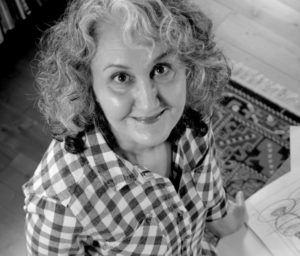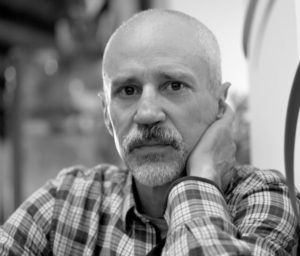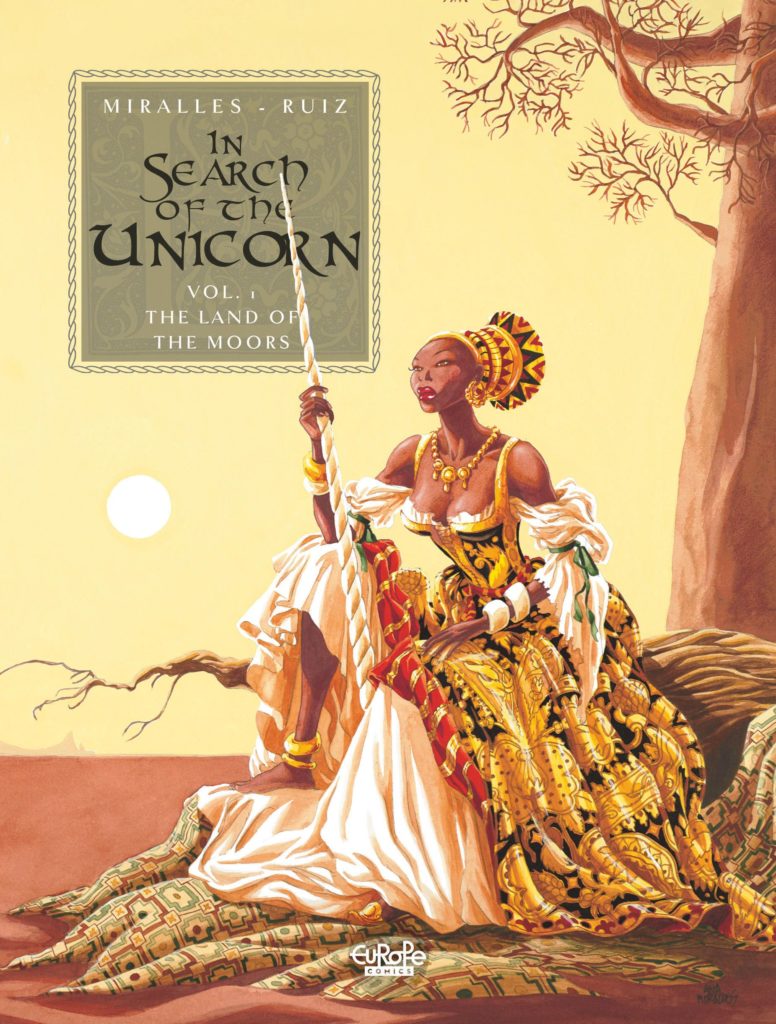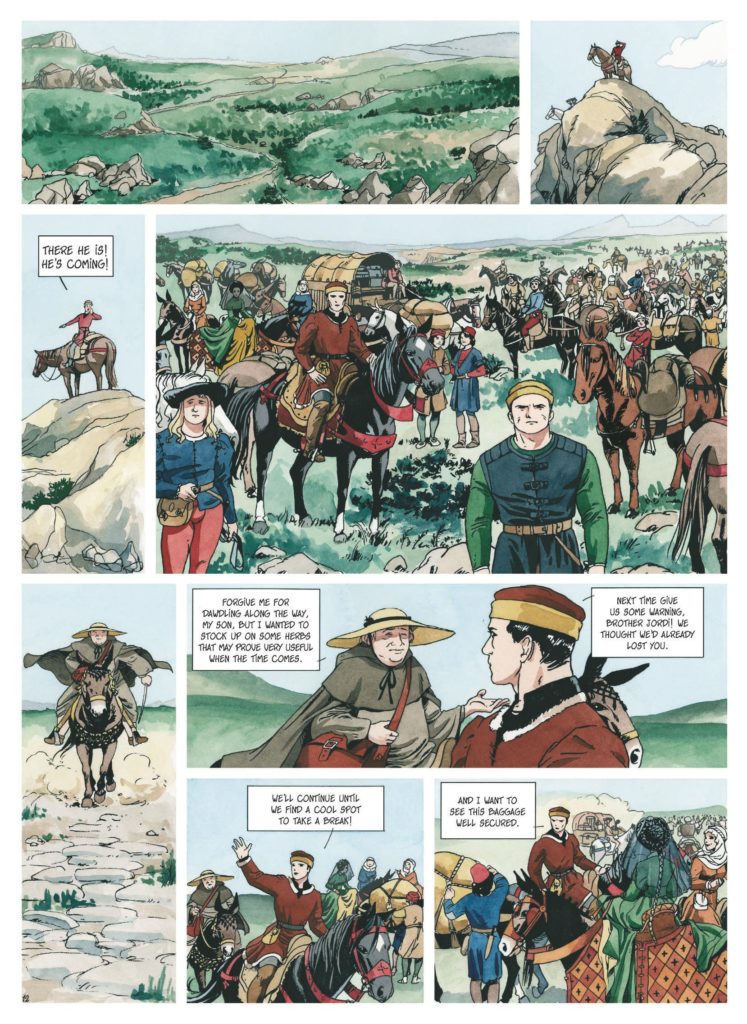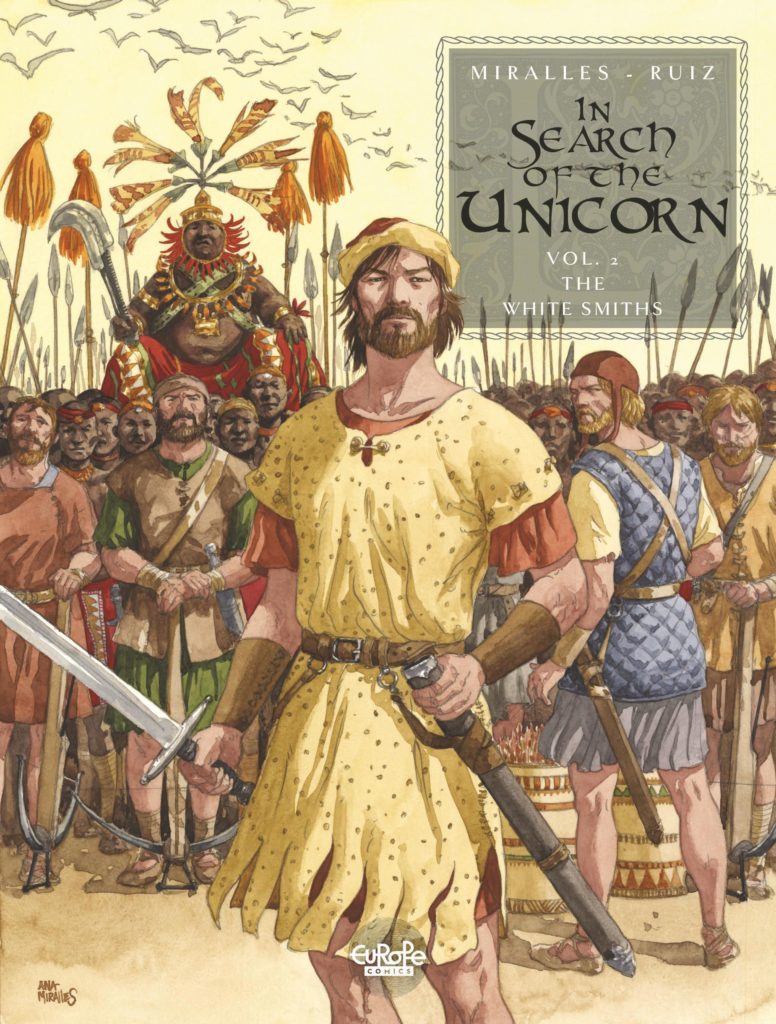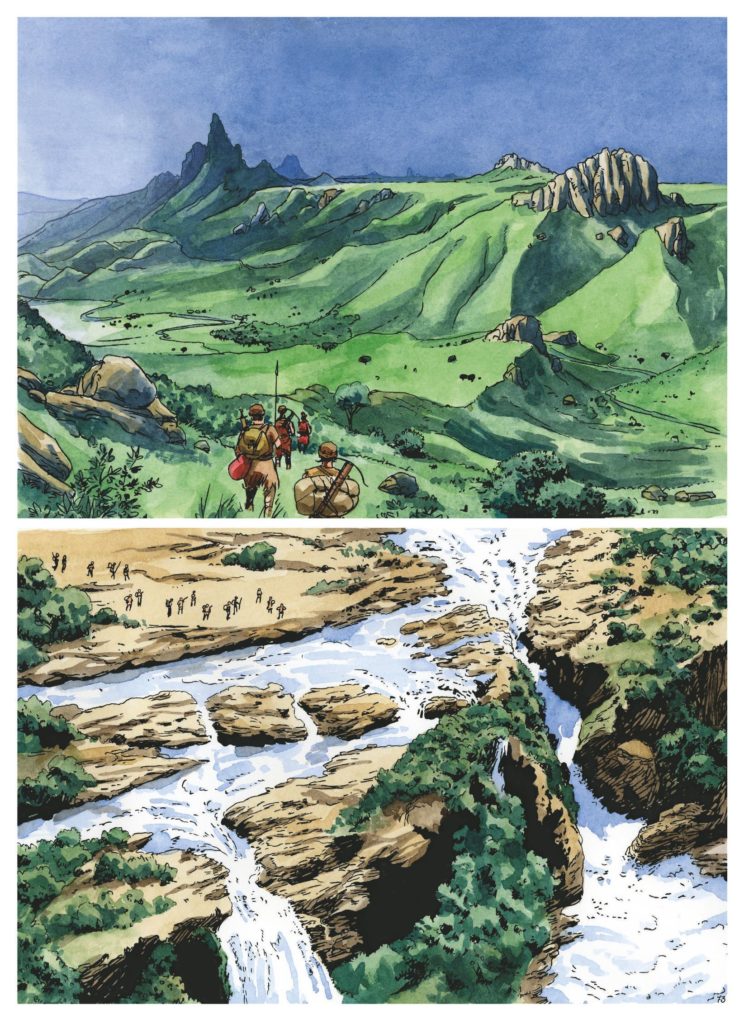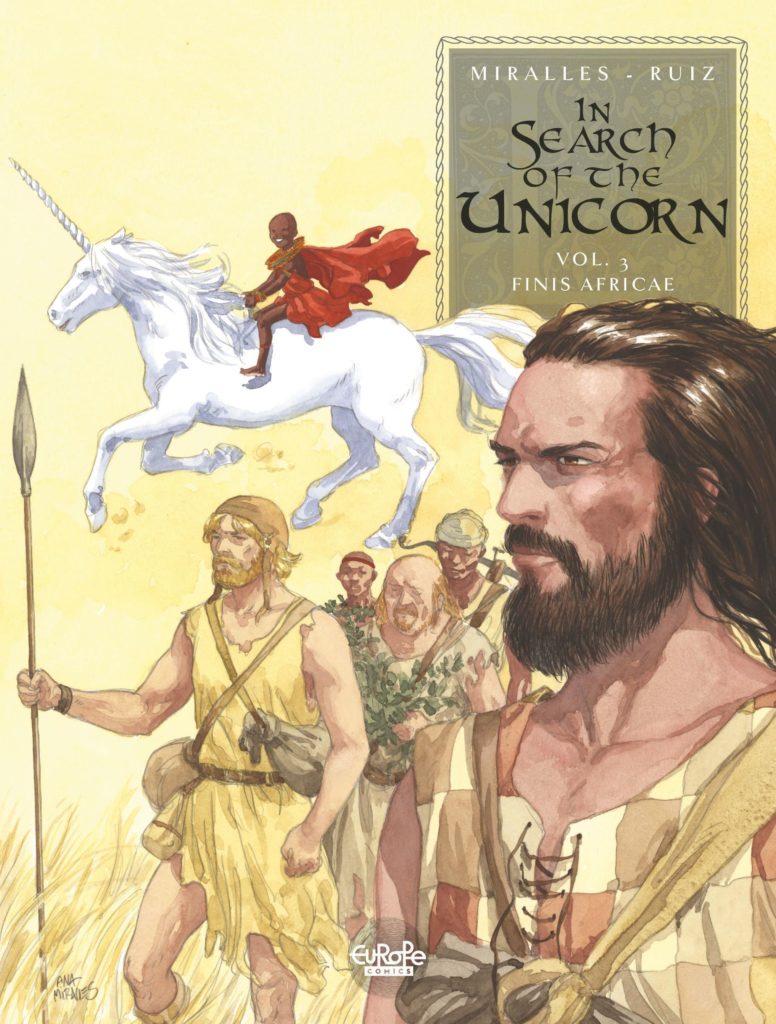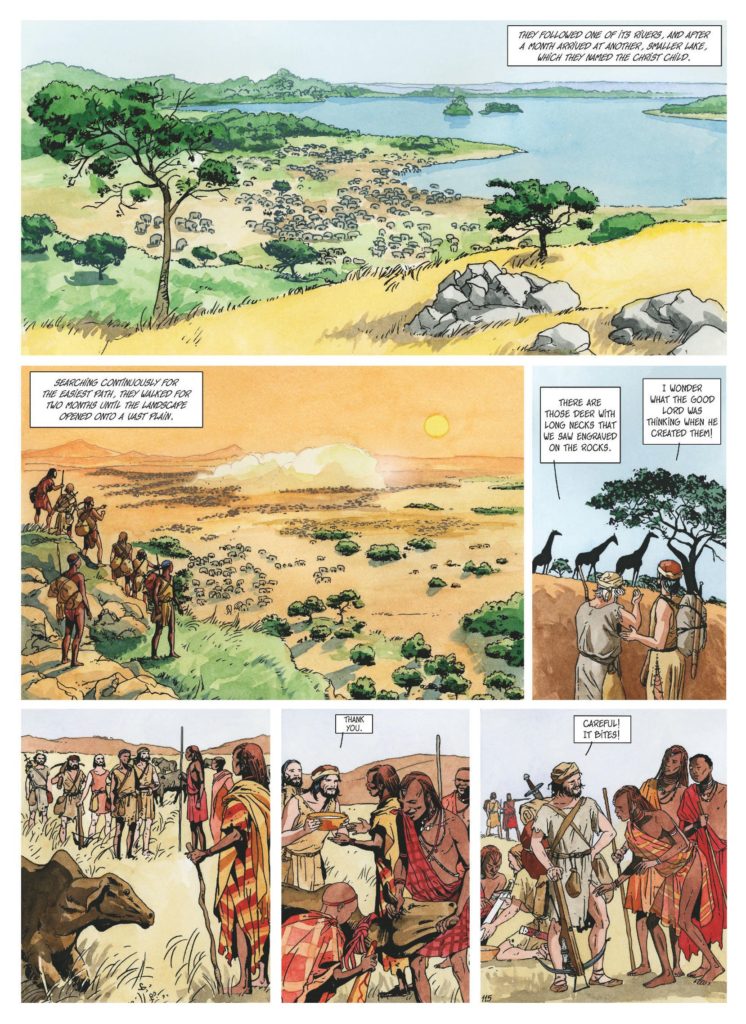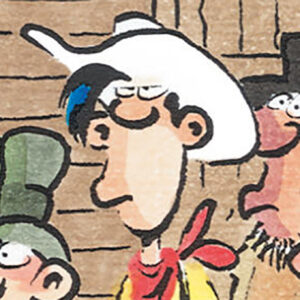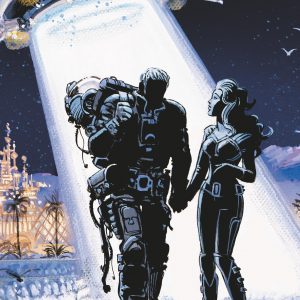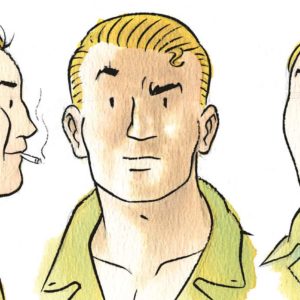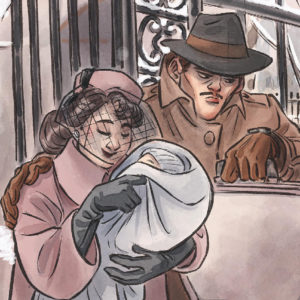From Oct. 4th – 7th the Europe Comics team will be traveling stateside for the 2018 New York Comic Con, and we have the privilege of bringing with us the Spanish duo Ana Mirallès and Emilio Ruiz, creators of the In Search of the Unicorn trilogy. Ana Mirallès is also the artist behind the best-selling historical adventure series Djinn, set to be published in October by Insight Comics. Be sure to stop by our booth #1558 for one of their signing sessions, and watch out for Ana as part of the “World Comics Invasion” panel on Fri. Oct. 5th. Full details here.
How did you decide to become creators of comics?
For each of us it was different. In Ana’s case, it happened very early. She had made her decision by the time she was 10 years old. She was always gifted at drawing, as one can see in all of her high school notebooks! Then she went on to study the fine arts, specializing in painting, given that at the time (’77-’82) there was no such thing as comics studies. In the case of Emilio, it was a decision he took later in life, which began with a collaboration he undertook with Ana in 1990, El brillo de una mirada (“The Shimmer”). Before that, he had also studied the fine arts, as well as working as a photojournalist, where he reported on theater, dance, and various exhibitions.
Both of you were born in Spain. How did you end up entering the Franco-Belgian comics scene? What has the experience been like?
It’s important to keep in mind the historical context. Here we’re talking about 1980s Spain, a time when the country was experiencing a vast and deep cultural evolution following 40 years under the dictatorship of Franco. There was an explosion of the press, and the general public suddenly discovered contemporary comics, which until then had been reserved to the few who were able to travel abroad. With such a cultural effervescence, it was easy to get published, although still difficult to make a living. For Ana, once she finished her studies, she had to focus her professional activities on whatever was most productive. For 10 years, she worked intensively for local institutions as well as children’s book publishers, textbook publishers, etc., all while continuing to publish comics in various forms, such as in fanzines, or magazines such as Rambla, which helped her make a name for herself. She also contributed to the avant-garde magazine Madriz, a real showcase at the time of modern Spain.
Eventually she met the Spanish scriptwriter Antonio Segura, and they traveled together to the Angouleme Comics Festival in a trip put together by the Valencia city council. There they quickly realized that there was another market open to them, a veritable El Dorado for Spanish artists like themselves. The contacts they made during that trip ultimately led to the series Eva Medusa, which allowed both of them to broaden their horizons and which helped Ana grow tremendously as an artist. As for Emilio, he wasn’t yet working in comics, and later jumped into the Franco-Belgian world without coming up through the Spanish publishers.
You worked together on the three-part story In Search of the Unicorn, with Emilio writing the script, and Ana illustrating. Tell us a bit about the story, and the creative process behind it. Which elements of these books did you find the most fascinating or challenging?
This trilogy is an adaptation of an award-winning novel by Spanish writer and historian Juan Eslava Galán. Ana, having loved the book, passed it on to Emilio, who immediately began thinking about the possibility of adapting it. What we liked about the book was its exceptional adventure, its great humanity, its well-constructed characters, and its language, an older form of Spanish that seemed to us both elegant and stimulating. We reached out to the author, and he showed great interest in the idea, on the condition that we respect the setting of the book. Of course we agreed, and his publisher Planeta gave us their permission to undertake the adaptation.
Our creative process was simple on the surface, but required a great deal of work and took us three years. Emilio first set to writing the script, Ana sketched a rough draft of the story, and we sent everything to Juan Eslava, who made sure that every element of the story fit the era, from the characters’ clothes to the details of each scene. He gave us the knowledge we needed for the book to be able to pass the test of any historian who might come along, which has made the trilogy into a true classic.
To be able to bring to life this kind of story, we faced numerous challenges. First of all for Emilio, as the writer, to be able to get to grips with the psychology of 15th-century Spaniards and write credible dialog. Especially given that the original book was written as a form of medieval chronicle, a combination of fantasy and reality, marked by actions both cruel and naïve on the part of the characters. Ana’s task was then to obtain visual documentation of every single element, at a time when that meant hunting through books, magazines, and museums, a considerable feat then as it would be now. These were three intense years full of research, reading, and creative pleasure where we worked together hand in hand to create the books that you can see today.
At first, the trilogy ended up in a historical collection with our initial publisher and was quickly forgotten, until Dargaud bought the rights and decided to republish the series in a single, hard-bound volume. We were then able to revisit and rework a number of small details throughout, as well as revising the original translation and adding 15 new pages to the story.
What projects are you currently working on? If you can share!
We are now working together on a new project about another of our shared passions, the cinema. Given that we’re still in the process of finding a publisher, it would be a bit premature to give too many details. However, we hope that we won’t disappoint our future readers, as we’re committed to bringing to life a story with everything that people have come to expect from us — from the authentic setting to our lovely lead character, as we delve further into the human soul. All of this colored by a classic sense of humor and a few tears along the way. Can we achieve this goal? That will be our next challenge.
Which other comics artists and writers inspire you? Who would you love to collaborate with, in Europe or beyond?
We’re both eclectic spirits, curious and open to new areas and themes. And comics are where our tastes diverge the most. Ana admires Hal Foster (especially his series Prince Valiant) as well as Hugo Pratt. Right behind them she would put a host of others, such as Tintin, Asterix, Moebius, Posy Simmonds, Gilbert Shelton, François Bourgeon, Beà, Guido Crepax, Muñoz and Carlos Sampayo, Sento, Jiro Taniguchi, Claire Bretécher, Carlos Giménez, and Lorenzo Mattotti.
Emilio also appreciates classic series like Tintin, Corto Maltese, and Asterix, and otherwise devotes his reading to authors like Joe Sacco, Jacques Tardi, Art Spiegelman, Will Eisner, Manu Larcenet, Juan Díaz Canalès, Rubén Pellejero, Régis Loisel, David Prudhomme, and Chloé Cruchaudet. In terms of working with other artists, neither of us imposes any limits on ourselves before taking on a given project.
Outside of comics, our influences are widespread and varied. In terms of art, we both love Flemish painting in general, especially Bruegel the Elder, Hieronymus Bosch, and Rubens. We also love Velázquez, Egon Schiele, Gustav Klimt, Joaquín Sorolla, Pinazo, Mariano Fortuny, Georges Braque, Ilya Repin, and Goyō Hashiguchi.
In terms of writers, Ana counts among her favorites the stories of Andrei Platonov, Julio Cortázar, and Jorge Luis Borges, the far-reaching writings of Juan Eslava Galán, Mikhail Bulgakov, Teresa Garbí, Miguel Hernández, Fernando Pessoa, Henry David Thoreau, Robert Graves, and the travel writings of Patrick Leigh Fermor. In his reading, Emilio usually prefers essays, especially having to do with science (such as Brian Greene) and history (for example Ian Buruma, Antony Beevor, and Martin Amis). He also reads biographies, such as those of Stefan Zweig and Montefiore, as well as general literature, usually on the advice of friends. At the moment he’s reading Menchu Gutiérrez and Robert Macfarlane.
Our favorite book is El Buscón, by Quevedo, and we share a favorite movie, To Be or Not to Be, by Lubitsch. In general we prefer classic films from the 1930s to 1950s, but we also enjoy science fiction, such as 2001: A Space Odyssey, Blade Runner, and Interstellar.
Header image: In Search of the Unicorn © Mirallès & Ruiz / Dargaud Benelux
